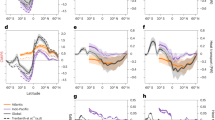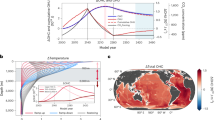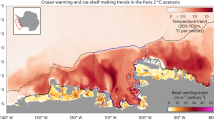Abstract
Climate modelers have recognized the possibility of abrupt climate changes caused by a reorganization of the North Atlantic's current pattern (technically known as a thermohaline circulation collapse). This circulation system now warms north-western Europe and transports carbon dioxide to the deep oceans. The posited collapse of this system could produce severe cooling in northwestern Europe, even when general global warming is in progress. In this paper we use a simple integrated assessment model to investigate the optimal policy response to this risk. Adding the constraint of avoiding a thermohaline circulation collapse would significantly reduce the allowable greenhouse gas emissions in the long run along an optimal path. Our analysis implies that relatively small damages associated with a collapse (less than 1% of gross world product) would justify a considerable reduction of future carbon dioxide emissions.
Similar content being viewed by others
References
Azar, C. and Rodhe, H.: 1997, ‘Targets for Stabilization of Atmospheric CO2’ Science 276, 1818–1819.
Barber, R. T. and Chávez, F. P.: 1986, ‘Ocean Variability in Relation to Living Resources during the 1982–83 El Niño’ Nature 319, 279–285.
Baumgartner, A. and Reichel, E.: 1975, The World Water Balance: Mean Annual Global, Continental and Maritime Precipitation, Evaporation and Run-Off, Elsevier Scientific Publishing, Amsterdam, New York, p. 179.
Bradford, D. F.: 1999, ‘On the Uses of Benefit-Cost Reasoning in Choosing Policy Toward Global Climate Change’ in Portney, P. R. and Weyant, J. P. (eds.), Discounting and Intergenerational Equity, Resources for the Future, Washington, D.C., pp. 37–44.
Broecker, W. S.: 1997, ‘Thermohaline Circulation, the Achilles Heel of Our Climate System: Will Man-Made CO2 Upset the Current Balance’ Science 278, 1582–1588.
Broecker, W. S. and Peng, T. H.: 1982, Tracers in the Sea, Eldigio Press, Lamont-Doherty Geological Observatory, Palisades, NY.
Cao, M. and Woodward, F. I.: 1998, ‘Dynamic Responses of Terrestrial Ecosystem Carbon Cycling to Global Climate Change’ Nature 393, 249–252.
Chao, H. P.: 1995, ‘Managing the Risk of Global Climate Catastrophe: An Uncertainty Analysis’ Risk Anal. 15, 69–78.
Constanza, R., d'Arge, R., deGroot, R., Farber, S., Grasso, M., Hannon, B., Limburg, K., Naeem, S., O'Neill, R. V., Paruelo, J., Raskin, R. G., Sutton, P., and van den Belt, M.: 1997, ‘The Value of the World's Ecosystem Services and Natural Capital’ Nature 387, 253–260.
Dowlatabadi, H.: 1995, ‘Integrated Assessment Models of Climate Change’ Energy Policy 23, 289–296.
Dowlatabadi, H. and Lave, L. B.: 1993, ‘Pondering Greenhouse Policy’ Science 259, 1381–1382.
Fan, S., Gloor, M., Mahlman, J., Pacala, S., Sarmiento, J. L., Takahashi, T., and Tans, P.: 1998, ‘A Large Terrestrial Carbon Sink in North America Implied by Atmospheric and Oceanic Carbon Dioxide Data and Models’ Science 282, 442–446.
Fankhauser, S.: 1994, ‘The Economic Costs of Global Warming Damage: A Survey’ Global Environ. Change 4, 301–309.
Fourer, R., Gay, D. M., and Kernighan, B. W.: 1993, AMPL, A Modeling Language for Mathematical Programming, Boyd and Fraser Publishing Company, Danvers, Mass., p. 351.
Grove, J. M.: 1988, The Little Ice Age, Methuen and Co., London, New York, p. 498.
Ha-Duong, M., Grubb, M. J., and Horcade, J. C.: 1997, ‘Influence of Socioeconomic Inertia and Uncertainty on Optimal CO2-Emission Abatement’ Nature 390, 270–273.
Hasselmann, K., Hasselmann, S., Giering, R., Ocana, V., and v. Storch, H.: 1997, ‘Sensitivity Study of Optimal CO2 Emission Paths Using a Simplified Structural Integrated Assessment Model (SIAM)’ Clim. Change 37, 345–386.
Heal, G.: 1997, ‘Discounting and Climate Change’ Clim. Change 37, 335–343.
Hourcade, J. C., Richels, R., Robinson, J., Chandler, W., Davidson, O., Edmonds, J., Finon, D., Grubb, M., Halsnaes, K., Hogan, K., Jaccard, M., Krause, F., LaRoche, E., Montgomery, W. D., Nastary, P., Pegov, A., Richards, K., Schratenholzer, L., Siniscalco, D., Shukla, P. R., Sokona, Y., Sturm, P., and Tudini, A.: 1996, ‘Estimating the Costs of Mitigating Greenhouse Gases’ in Climate Change 1995, Economic and Social Dimensions of Climate Change, Contribution of Working Group II, Cambridge University Press, Chapter 8, pp. 263–296.
Ishitani, H. and Johansson, T. B.: 1996, ‘Energy Supply Mitigation Options’ in Climate Change 1995, Impacts, Adaptations and Mitigation of Climate Change: Scientific-Technical Analysis, Contribution of Working Group II, Cambridge University Press, Chapter 19, pp. 598–647.
Joos, F.: 1994, ‘Imbalance in the Budget’ Nature 370, 181–182.
Kaiser, J.: 1998, ‘Possibly Vast Greenhouse Gas Sponge Ignites Controversy’ Science 282, 386–387.
Kaufmann, R. K.: 1997, ‘Assessing the DICE Model: Uncertainty Associated with the Emission and Retention of Greenhouse Gases’ Clim. Change 35, 435–448.
Lempert, R. J., Schlesinger, M. E., and Hammitt, J. K.: 1994, ‘The Impact of Potential Abrupt Climate Changes on Near-Term Policy Choices’ Clim. Change 26, 351–376.
Lorius, C., Jouzel, J., Raynaud, D., Hansen, J., and Le Treut, H.: 1990, ‘The Ice Core Record: Climate Sensitivity and Future Greenhouse Warming’ Nature 347, 139–145.
Maddison, D.: 1995, ‘A Cost-Benefit Analysis of Slowing Climate Change’ Energy Policy 23, 337–346.
Manabe, S. and Stouffer, R. J.: 1993, ‘Century-Scale Effects of Increased Atmospheric CO2 on the Ocean-Atmosphere System’ Nature 364, 215–218.
Manne, A. S.: 1995, ‘The Rate of Time Preference: Implications for the Greenhouse Debate’ Energy Policy 23, 391–394.
Nordhaus, W. D.: 1992, ‘An Optimal Transition Path for Controlling Greenhouse Gases’ Science 258, 1315–1319.
Nordhaus, W. D.: 1994, Managing the Global Commons: The Economics of Climate Change, The MIT Press, Cambridge, Mass., p. 213.
Nordhaus, W. D.: 1997, ‘Discounting in Economics and Climate Change: An Editorial Comment’ Clim. Change 37, 315–328.
Nordhaus, W. D. and Popp, D.: 1997, ‘What is the Value of Scientific Knowledge? An Application to Global Warming Using the PRICE Model’ Energy J. 318, 1–45.
Parson, E. A. and Keith, D. W.: 1998, ‘Fossil Fuels Without CO2 Emissions’ Science 282, 1053–1054.
Pearce, D. W., Cline, W. R., Achanta, A. N., Fankhauser, S., Pachauri, R. K., Tol, R. S. L., and Vellinga, P.: 1996, ‘The Social Costs of Climate Change: Greenhouse Damage and the Benefits of Control’ in Climate Change 1995: Economic and Social Dimensions of Climate Change, Cambridge University Press, Chapter 6, pp. 181–224.
Peck, S. and Teisberg, T.: 1994, ‘Optimal Carbon Emission Trajectories when Damages Depend on the Rate or Level of Global Warming’ Clim. Change 28, 289–314.
Rahmstorf, S.: 1996, ‘On the Freshwater Forcing and Transport of the Atlantic Thermohaline Circulation’ Clim. Dyn. 12, 799–811.
Rahmstorf, S.: 1997, ‘Risk of Sea-Change in the Atlantic’ Nature 388, 825–826.
Rahmstorf, S. and Ganopolski, A.: 1999, ‘Long-Term Global Warming Scenarios Computed with an Efficient Coupled Climate Model’ Clim. Change 43, 353–367.
Richels, R. and Edmonds, J.: 1995, ‘The Economics of Stabilizing Atmospheric CO2 Concentrations’ Energy Policy 23 373–378.
Roughgarden, T. and Schneider, S. H.: 1999, ‘Climate Change Policy: Quantifying Uncertainties for Damages and Optimal Carbon Taxes’ Energy Policy 27, 415–429.
Sarmiento, J. L. and Le Quéré, C.: 1996, ‘Oceanic Carbon Dioxide Uptake in a Model of Century-Scale Global Warming’ Science 274, 1346–1350.
Schiller, A., Mikolajewicz, U., and Voss, R.: 1997, ‘The Stability of the North Atlantic Thermohaline Circulation in a Coupled Ocean-Atmosphere General Circulation Model’ Clim. Dyn. 13, 325–347.
Schmittner, A. and Stocker, T. F.: 1999, ‘The Stability of the Thermohaline Circulation in Global Warming Experiments’ J. Climate 12, 1117–1133.
Schultz, P. A.: 1996, Optimal Reductions in CO 2 Emissions, Ph.D. Thesis, Pennsylvania State University.
Schulz, P. A. and Kasting, J. F.: 1997, ‘Optimal Reductions in CO2 Emissions’ Energy Policy 25, 491–500.
Stocker, T. F.: 1999, ‘Abrupt Climate Changes: From the Past to the Future-a Review’ Int. J. Earth Sci. 88, 365–374.
Stocker, T. F. and Schmittner, A.: 1997, ‘Influence of CO2 Emissions Rates on the Stability of the Thermohaline Circulation’ Nature 388, 862–865.
Stouffer, R. J. and Manabe, S.: 1999, ‘Response of a Coupled Ocean-Atmosphere Model to Increasing Atmospheric Carbon Dioxide: Sensitivity to the Rate of Increase’ J. Climate 12, 2224–2237.
Tol, R. S. J.: 1997, ‘On the Optimal Control of Carbon Dioxide Emissions: An Application of FUND’ Environ. Model. Assess. 2, 151–163.
Tol, R. S. J.: 1998, ‘Potential Slowdown of the Thermohaline Circulation and Climate Policy’ Discussion Paper DS98/06 Institute for Environmental Studies Vrije Universiteit Amsterdam.
Tol, R. S. J. and de Vos, A. F.: 1998, ‘A Bayesian Statistical Analysis of the Enhanced Greenhouse Effect’ Clim. Change 38, 87–112.
Toth, F. L., Bruckner, T., Fussel, H.-F., Leimbach, M., Petschel-Held, G., and Schnellhuber, H.: 1997, ‘The Tolerable Windows Approach to Integrated Assessments’ in Proceedings of the IPCC Asia-Pacific Workshop on Integrated Assessment Models [IAMs], United Nations University, Japan.
Toth, F. L., Petschel-Held, G., and Bruckner, T.: 1998, ‘Kyoto and the Long Term Climate Stabilization’ in OECD Workshop on Climate Change and Economic Modelling, Background Analysis for the Kyoto Protocol, September 17–18, OECD Headquarters, Paris.
UNFCCC: 1992, U.N. Framework Convention on Climate Change, Published by IUCC/UNEP (Information Unit on Climate Change), Geneva.
Vanderbei, R. J.: 1997, ‘LOQO User's Manual-Version 3.10’ Technical Report SOR–97–08, Princeton University, Statistics and Operations Research.
WBGU: 1995, Szenario zur Ableitung Globaler CO 2 -Reduktionsziele und Umsetzungsstrategien, Wissenschaftlicher Beirat der Bundesregierung Globale Umweltveränderungen (WBGU), Geschäftsstelle am Alfred-Wegener-Institut für Polar-und Meeresforschung.
Weyant, J., Davidson, O., Dowlatabadi, H., Edmonds, J., Grubb, M., Parson, E. A., Richels, R., Rotmans, J., Shukla, P. R., Tol, R. S. J., Cline, W., and Fankhauser, S.: 1996, ‘Integrated Assessment of Climate Change: An Overview of Approaches and Results’ in Climate Change 1995, Economic and Social Dimensions of Climate Change, Cambridge University Press, Chapter 10, pp. 369–396.
Wigley, T. M. L., Richels, R., and Edmonds, J. A.: 1996, ‘Economic and Environmental Choices in the Stabilization of Atmospheric CO2 Concentrations’ Nature 379, 240–243.
Wood, R. A., Keen, A. B., Mitchell, J. F. B., and Gregory, J. M.: 1999, ‘Changing Spatial Structure of the Thermohaline Circulation in Response to Atmospheric CO2 Forcing in a Climate Model’ Nature 399, 572–575.
Author information
Authors and Affiliations
Rights and permissions
About this article
Cite this article
Keller, K., Tan, K., Morel, F.M.M. et al. Preserving the Ocean Circulation: Implications for Climate Policy. Climatic Change 47, 17–43 (2000). https://doi.org/10.1023/A:1005624909182
Issue Date:
DOI: https://doi.org/10.1023/A:1005624909182




